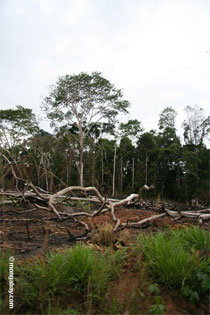Governments making progress in fight against illegal logging says FAO
mongabay.com
December 3, 2005
Governments are becoming increasingly innovative in devising ways to control illegal logging claims new research released by the Food and Agriculture Organization of the United Nations (FAO) and the International Tropical Timber Organization (ITTO).
Illegal logging is quite costly, especially for developing countries. According to World Bank estimates, governments lose about US$5 billion in revenues annually as a result of illegal logging while overall losses to the national economies of timber producing countries add up to an additional US$10 billion per year.
Beyond economic losses from smuggled timber, illegal logging results in deforestation which reduces biodiversity, makes forests more susceptible to fire, and contributes to climate change by producing greenhouse gases. Research released in September found that Brazil’s Amazon rain forest is being degraded twice as fast as deforestation figures suggest due to “selective logging,” much of it illegal.
Worldwide, logging is an important contributor to deforestation. New figures released by FAO show that while the total area of forest lost each year has fallen since the 1990s, deforestation still is around 13 million hectares per year. Of this amount, about 6 million hectares of primary, or old-growth, forest are destroyed. The loss of primary forest is important because it more biologically rich than secondary forests and plantations. The conversion of forest land for agriculture is the largest contributor to deforestation today.
Below is the FAO news release detailing the new report.
Governments making progress in curbing illegal logging
1 December 2005
FAO news release
New research conducted by FAO and the International Tropical Timber Organization (ITTO) suggests that governments are becoming increasingly innovative — and effective — in tackling the problem of illegal logging.
 Deforestation in Peru. Picture by R. Butler Rainforests worth $1.1 trillion for carbon alone in Coalition nations – 11/29/2005 If a coalition of developing countries has its way, there could soon be new forests sprouting up in tropical regions. The group of ten countries, led by Papua New Guinea, has proposed that wealthy countries pay them to preserve their rainforests. The Coalition for Rainforest Nations argues that all countries should pay for the benefits — from carbon sequestration to watershed protection — that tropical rainforests provide. Developing countries: pay us to save rainforests – 11/27/2005 Carbon in Canada’s boreal forest worth $3.7 trillion – 11/25/2005 Nigeria has worst deforestation rate, FAO revises figures – 11/17/2005 US ranks #7 in global forest loss, Nigera has worst deforestation rate – 11/16/2005 “Stealth logging” doubles amount of rain forest disturbance in the Amazon – November 1, 2005
|
The research is summarized in a recently-published joint FAO-ITTO report, Best Practices for Improving Law Compliance in the Forest Sector, which highlights successful efforts to combat illegal logging undertaken in eleven countries: Bolivia, Cambodia, Cameroon, Ecuador, Honduras, Indonesia, Italy, Malaysia, Mozambique, Nicaragua and Peru.
“The report gives examples of some of the innovative approaches already being used by governments, and by focusing on success stories it is really the first study of its kind to outline remedial actions instead of just dwelling on the problem of illegal logging,” said Eva Muller, an FAO forest expert.
Although it is too early to quantify the success of the measures highlighted in the report, added ITTO expert Steven Johnson, some of them are producing visible improvements. “By sharing these successful case studies, ITTO and FAO hope to provide guidance to other countries wrestling with the problem of illicit logging,” he said.
Billions lost to illegal logging
FAO’s most recent Gobal Forest Resources Assessment found that while the world’s rate of net forest loss is slowing, deforestation is still happening at an alarmingly high rate — about 13 million hectares per year. Most of that loss occurs as a result of forests being converted to agricultural land, but illegal logging plays a role too.
According to World Bank estimates, governments lose revenues totalling around US$5 billion annually as a result of illegal logging — overall losses to the national economies of timber producing countries add up to an additional US$10 billion per year.
Beyond financial impacts, illegal logging also leads to unsustainable forest management, distorts timber markets and can exacerbate income disparities, note FAO and the ITTO.
What counter-measures are working?
Best Practices for Improving Law Compliance in the Forest Sector highlights a wide range of approaches being used by governments to deal with illicit logging.
For example, in 2000 Ecuador created a mechanism, called the Regencia forestal, under which independent professional foresters check to ensure that forest operators are complying with laws and regulations. Violations can lead to the revocation of operating licenses or other penalties.
Ecuador also established check-points between its forests and the locations where wood processing and marketing occurs — this measure resulted in a six-fold increase in government seizures of illegally-produced timber during its first year of implementation.
In Cambodia, the promotion of community-managed forestry management, a system in which local communities own and manage forests, helped to limit forest crime.
The government of Gambia streamlined harvesting guidelines and recognized local forest management rules, making it easier for small-scale forest operators to comply with regulations and abide by the law.
The report, which provides numerous other examples of steps being taken to put an end to illegal logging, also highlights four overarching areas where policy reforms can help:
- making forestry laws and policies more rational, equitable, transparent and streamlined;
- improving monitoring and information gathering;
- strengthening national capacities to enforce compliance;
- ensuring that policies take into account the economic and social dynamics that underlie illegal logging.
Best Practices for Improving Law Compliance in the Forest Sector is available online at:
http://www.fao.org/docrep/008/a0146e/a0146e00.htm